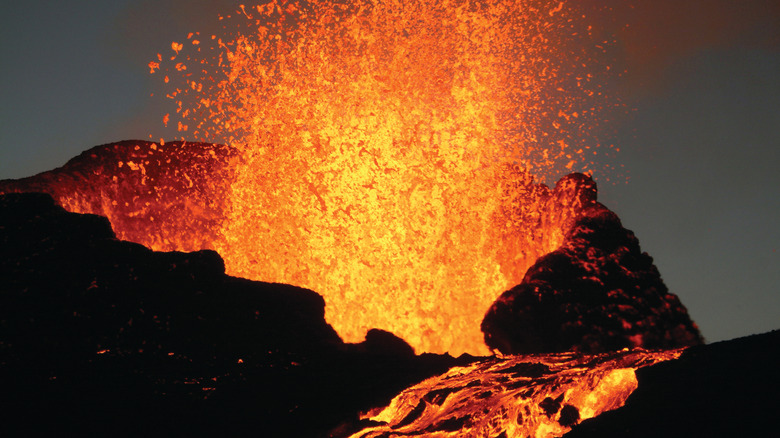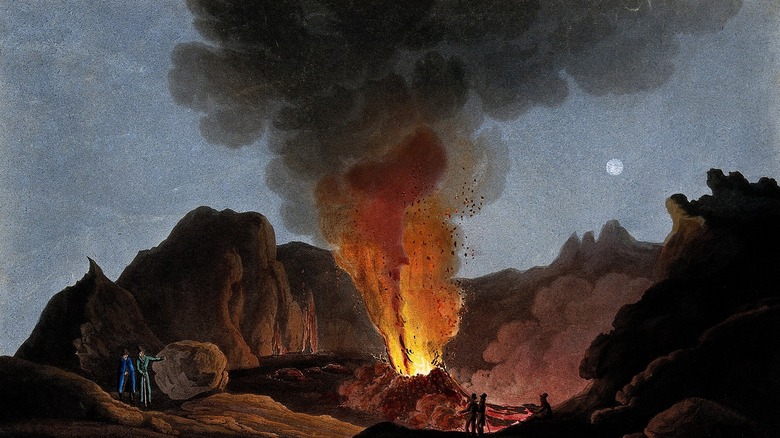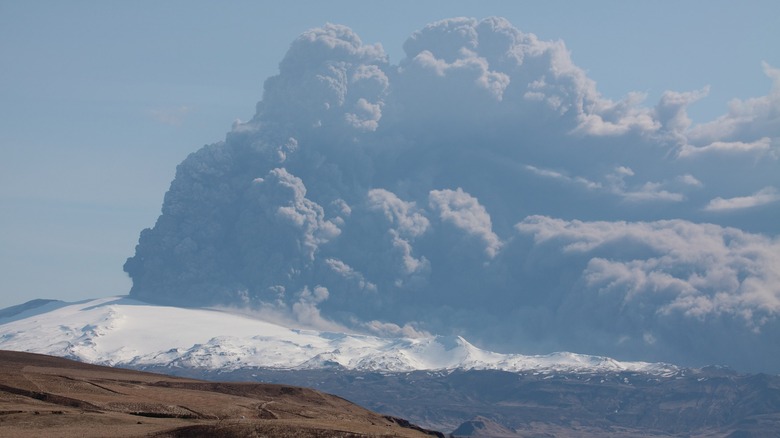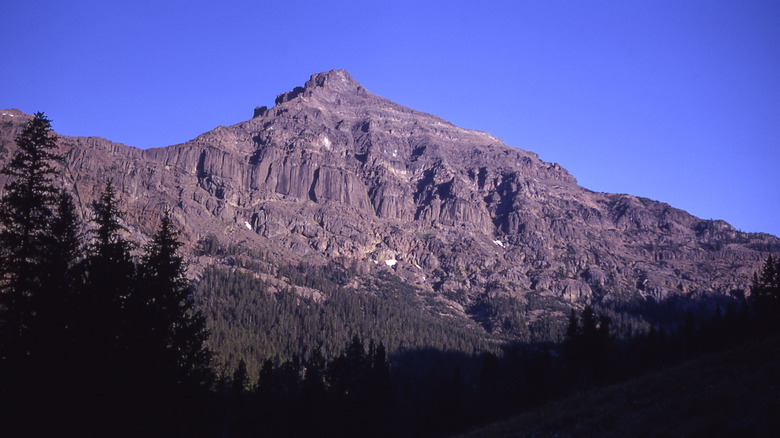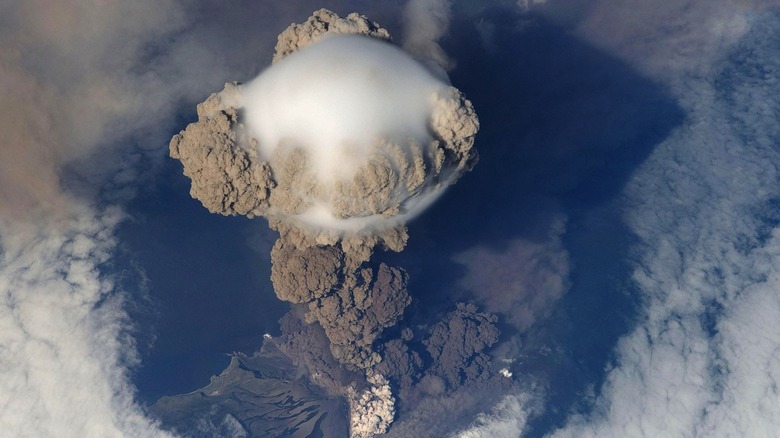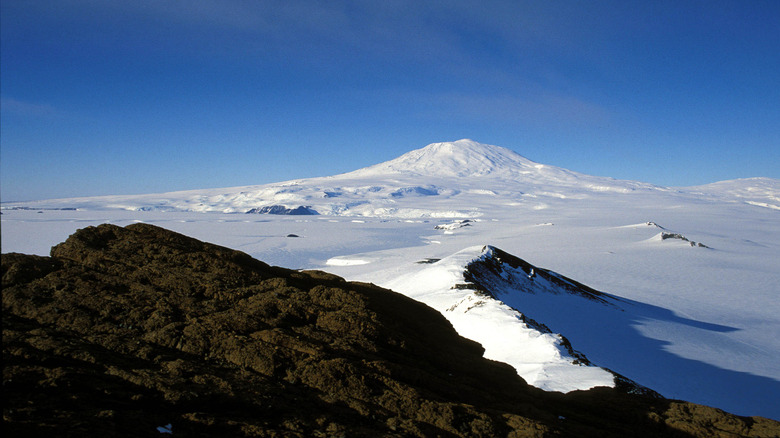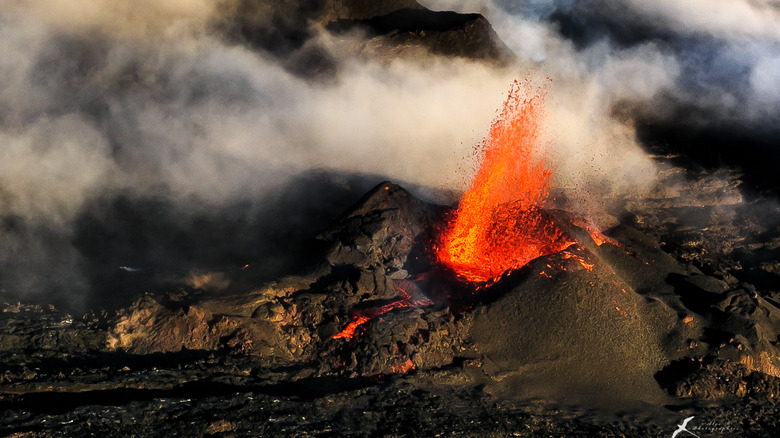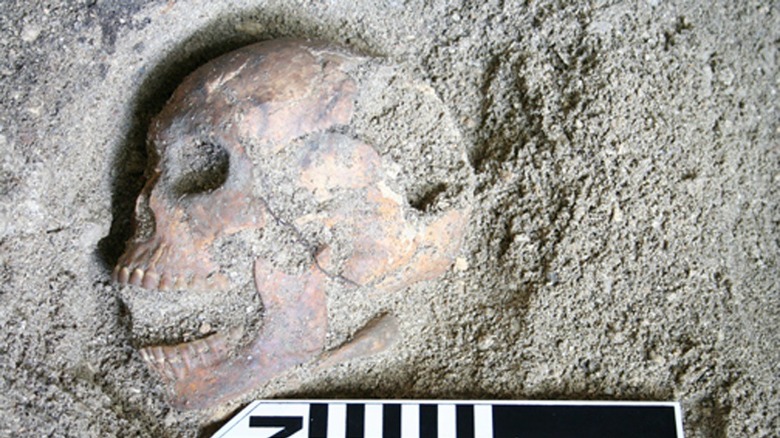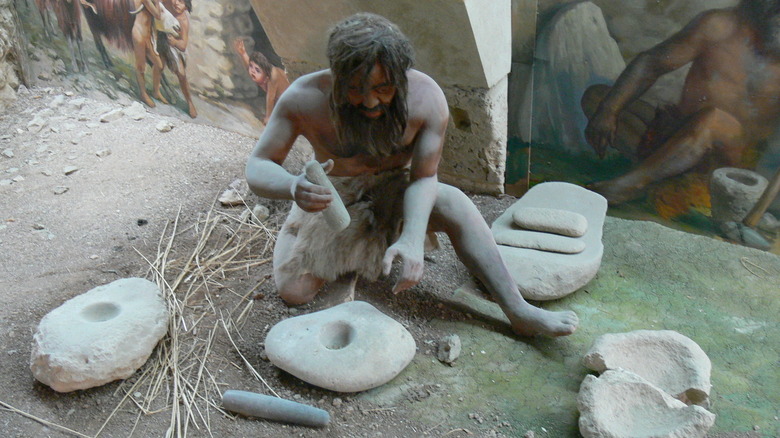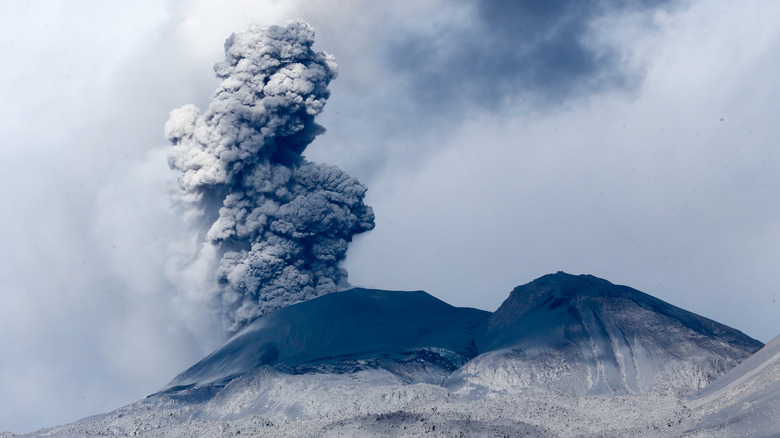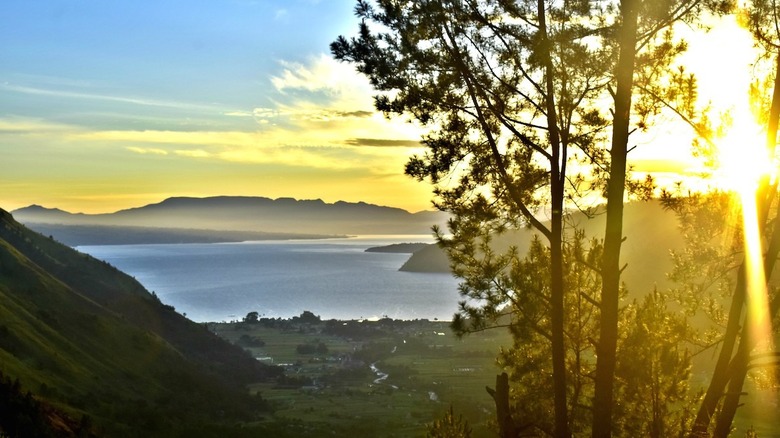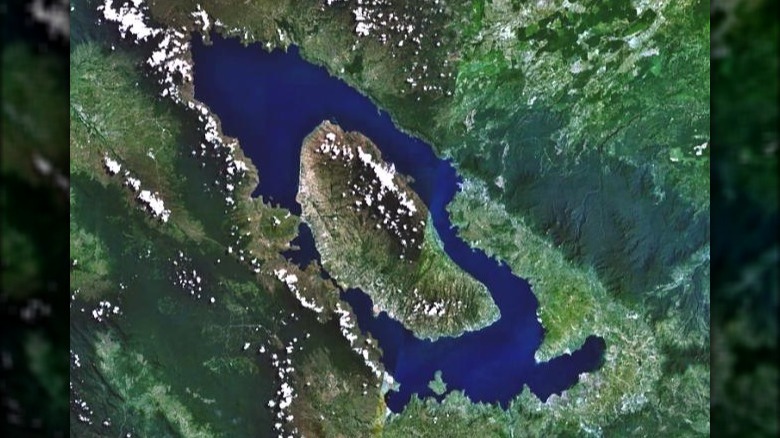The Largest Volcanic Eruption In History Explained
Volcanoes are a pretty popular topic, and for good reason. From a scientific perspective, there's a lot we can learn about these features, from the effects of eruptions on ecosystems to what they tell us about the inner workings of our own planet. And, from a lay person's point of view, they're just cool. Few things can really catch your attention more than a mountain blowing its top, after all. The sheer power and awe of an erupting volcano is something that never fails to compel us, even as we're hopefully running far away from its destructive forces.
Of course, when we talk about destructive things, it's natural for us to think about the biggest and baddest. In the world of volcanoes, these extremes do indeed get pretty serious. So, what's the biggest volcanic eruption that we know of? You might first think of relatively modern eruptions, like 1991's bombastic Pinatubo eruption in the Philippines (via USGS) or Tambora's 1815 eruption, which led to the "Year Without a Summer." And while both were pretty terrifying in their own rights, they don't even approach the massive impact of supervolcanoes.
Per the USGS, a "supervolcano" is one that reaches an eight on the Volcanic Explosivity Index and has at least once produced more than 240 cubic miles of material in an eruption. Only a few features have met this criteria, and there's one that clearly sits above the rest: Indonesia's Toba. This is the largest known volcanic eruption in our planet's history.
Toba wasn't your average volcano
When you think of a "classic" volcano, chances are good that you're probably imagining a single, mountainous sort of thing with a single eruption point. Think Italy's Mount Etna, for instance, or maybe the near constantly-erupting Hawaiian volcanoes of Mauna Loa and Kilauea. And while those types of volcanoes do happen, they're not the only sort out there spewing forth lava, ash, and gas. According to the USGS, volcanoes generally fall into one of four categories: cinder cones, composite volcanoes, shield volcanoes, and lava domes. The Toba eruptions actually came from a caldera complex that was host to multiple lava domes, many of which appear to have formed after the biggest known eruption, called the Youngest (or Young) Toba Tuff, per Communications Earth & Environment. Lava domes are typically created when especially thick, viscous magma builds up over time, pushing the earth above up into the characteristic dome shape.
This means that the massive Toba eruption of around 74,000 years ago actually stemmed from a larger volcanic system with multiple vents, rather than a single, explosive mountain. Oregon State reports that the caldera system is an estimated 18 by 60 miles and has experienced multiple significant eruptions over the years, including two previous ones around 840,000 and 700,000 years ago. It appears that the Young Toba Tuff eruption of 74,000 years ago emerged from fissures around what's now Lake Toba, formed from the collapsed caldera.
Toba threw out a lot of material
Toba was a pretty big deal. Though we don't have any direct reports from humans who were in the region at the time, a careful study of the ash deposits, caldera, and other physical evidence left behind by the eruption show us that it was significant. According to Science, it is still the largest known eruption within the past 2 million years. What's even more significant is that it produced two orders of magnitude more material than the 1815 eruption of Mount Tambora, which itself is one of the largest eruptions in recorded history.
As for material, Toba had a lot of it. Per Oregon State, the Young Toba Tuff eruption produced about 2,800 cubic kilometers of stuff. The 1980 eruption of Mt. St. Helens, by contrast, produced a single cubic kilometer. Ash from the eruption would have blanketed about half of the United States (not including Alaska or Hawaii) and appears to have made it all the way from its original site in Indonesia to the Middle East.
It was also an 8 on the Volcanic Explosivity Index (VEI), the highest level possible on the scale. By contrast, ThoughtCo reports that Tambora, which has the largest recorded loss of life due to a volcano and led to a volcanic winter that killed thousands more, was a 7. If anyone was close to Toba when it finally erupted after years of building pressure, they wouldn't have had very long to consider the danger.
There have been other massive volcanic eruptions throughout history
Though Toba seems pretty well situated to take its spot as the largest eruption ever, it's not alone when it comes to mega eruptions. Within recorded history, there's Mount Tambora, also in Indonesia, whose 1815 eruption proved especially devastating. Within the 20th century, the United States experienced a large eruption of Alaska's Novarupta volcano in 1912, though 1980's eruption of Mt. St. Helens in Washington state was far more deadly (via USGS).
The US has seen some mega eruptions that approach the sheer power of Toba, though these occurred long before anatomically modern humans hit the scene. According to the USGS, the largest eruption of the Yellowstone caldera in modern-day Wyoming happened about 2 million years ago and produced a staggering 600 cubic miles of material. Another eruption in the caldera occurred about 630,000 years ago that generated 240 cubic miles, while another nearby eruption 1.3 million years ago created 67 cubic miles of material.
Yellowstone appears to be the latest in a series of volcanic hot spots in the region, says the USGS. The movement of the earth's crust has shifted the center of the spot every few million years, meaning that Yellowstone and its caldera will remain geologically active for quite a while longer. And, no, though it would make for a decent cheesy disaster movie, we still don't have to worry about Yellowstone suddenly erupting and plunging us into a volcanic winter, reports Scientific American.
Toba had an effect on the world's climate
"Volcanic winter" is a phrase that gets thrown around quite a lot when talk turns to supervolcanoes. The idea goes that, if a volcano erupts extra ferociously and spews enough material into our planet's atmosphere, the cloud will form a thick layer and the sun's warming rays won't reach through it to the Earth's surface. Plants wither and die, animals and humans starve, and we suffer through a volcanic winter that would make "The Day After Tomorrow" look humdrum.
While that's a pretty wild oversimplification of things — no, not even the Toba volcano appears to have caused bodies of water on the other side of the planet to freeze over — the truth is that volcanoes can have a significant impact on climate. According to the USGS, many will throw out significant amounts of sulfur compounds in fine, aerosolized particles that are suspended in our atmosphere and reflect sunlight. That's how the 1991 Pinatubo eruption managed to lower the Earth's temperature by a pretty staggering 1.3 degrees Fahrenheit. However, it's worth noting that other gases spewed by volcanoes aren't quite as destructive. Volcanoes do emit a decent amount of carbon dioxide, but currently it's nowhere near the amount emitted by human activity.
Per PBS, there are signs that Toba did cool down the planet. Some have even gone so far as to say that Toba pushed our globe into an ice age, though that claim remains controversial.
It didn't plunge the planet into an ice age
Though it's pretty clear that volcanoes can have a significant effect on climate, the distant past of the biggest Toba eruption makes that hard to pin down. As PBS reports, some initially believed that the eruption may have kicked off an ice age. The theory looks tempting at first glance, given that there really was a significant cold period for about 1,000 years afterward. And it's pretty clear that a massive volcanic eruption with plenty of sunlight-reflecting sulfur in the atmosphere in the aftermath could produce a pretty darn noticeable effect on the climate. But was Toba the culprit for this particular ice age?
Not really. Studies of climatological data indicate that the global cooling period may have begun before the Toba eruption. The volcano wouldn't have made things easier on plant and animal life, to be sure, but it doesn't seem entirely fair to blame an entire ice age on this geological feature.
What's more, evidence linking the volcano to the plummeting temperatures is pretty weak. According to the BBC, sediment samples taken from Lake Malawi produced no such smoking gun. Given that the lake has a pretty stellar reputation for preserving ancient climate change data in its mud, this is a significant hit to the ice age theory. However, Oxford University scientists did find evidence of volcanic glass from Toba that landed about 7,000 kilometers (or a little over 4,300 miles) away from the eruption.
The Toba eruption wasn't one and done
The biggest, most destructive eruption in the Toba caldera was the one that produced the Young Toba Tuff about 74,000 years ago. But you simply can't keep a good volcano down, especially one that's in a place as seismically active as Indonesia. After the main eruption, the volcanic caldera experienced ongoing eruptions and seismic events as the region readjusted. Oregon State University reports that such a "recovery" can take thousands of years as the massive magma chamber and the surrounding rock readjust to the sudden release in pressure and change in the landscape. Eruptions kept popping up for somewhere between 15,000 to 20,000 years, while the changes in the geology of the region are arguably still happening even today. Researchers were able to make these estimates in part by sampling lake sediments from what's now Lake Toba, a body of water that formed in the volcano's collapsed caldera.
What's more, the "Young Toba" eruption wasn't even the first in the area. It was apparently the last of four major eruptions in what's called the Toba Caldera Complex, according to the Smithsonian Institution. Yet, the Pleistocene eruptions that preceded the Young Toba Tuff surely were pretty destructive in their own right.
Scientists once thought Toba killed off many humans
One of the most eye-catching aspects of the Toba story, apart from the absolutely gigantic volcano system blowing its top in spectacular fashion, is its supposed effects on Earth's inhabitants. Namely, quite a few folks have been interested in how such a massive eruption and its climate effects could have influenced the development of our species.
At 74,000 years ago, anatomically modern humans (that is, Homo sapiens) had already emerged and were busy moving out of Africa and into the Asian and European continents (via New Scientist). But we were still pretty far away from things like agriculture, industry, sturdy housing, and the development of air filters that could mitigate the effects of floating volcanic ash. So, how did early humans manage when Toba came calling?
Pretty poorly, according to one way of seeing it. Journalist Ann Gibbons posited a "bottleneck" theory, wherein the effects of Toba's eruption were so severe that humanity's numbers were whittled down to frighteningly bare levels (via Science). Dipping climate numbers and poor food sources in the aftermath would have been largely to blame. Some estimates have taken things to pretty extreme levels, reports NPR, with a few going so far as to say that the climatological changes were so severe that there were mere hundreds of us left. One study even claimed that it was possible there were only 40 pairs of fertile humans remaining in the wake of the eruption.
Toba probably didn't devastate our species, though
However dire previous studies may have made things sound, more recent research has hinted that Toba's mega-eruption wasn't quite as heinous to our population numbers as we once thought. A 2018 study published in Nature shows that there was a pretty healthy-looking group of people living in southern Africa at the time. Indeed, they weren't just maintaining themselves — they seemed to be thriving. It could be that people here fared especially well because they were close to the sea and its rich sources of food, which would have been less dramatically affected by volcano-induced climate change.
Another study published in Nature Communications, this time in 2020, also shows that people closer to Toba in India were doing pretty well, too. The presence of obviously human-worked stone tools shows that, not only were there people in the region around the time of the eruption, but that they appear to have been actively migrating there from Africa. What's more, stone tools in southern India were uncovered before and after a thick layer of ash from Toba hit the area (via Science).
As if that weren't enough, it seems as if people were living even closer to Toba both before and after it erupted. Fossilized human teeth uncovered in a Sumatran cave indicate as such, says Nature, showing that our species could be relatively close to the seemingly catastrophic eruption and still survive in decent numbers.
Toba has revealed new info about supereruption cycles
Many volcanoes are kind of like the Terminator — they just keep coming back, again and again, even if you didn't really ask for a sequel in the first place. To be fair, unlike Arnold Schwarzenegger, volcanic systems can take their time. They can return through cycles that take thousands, if not millions of years, so the vast majority of us really don't need to worry about our local, largely dormant volcano blowing its top. But the Toba caldera is still fairly active and indeed remained so for many, many years after the biggest eruption 74,000 years ago. As a result, scientists have been able to glean a ton of information about the cycles of eruption, recovery, and resurgence that can feed these complex volcanic systems for millennia.
According to Eos, one of the key parts of these cycles is a state known as "resurgence." For volcanoes like Toba, the main eruption tends to happen courtesy of a large magma chamber beneath the earth. After that chamber has emptied over the course of a mega eruption, the area still needs to readjust. For Toba, that meant a series of smaller eruptions that apparently used cooler material moving through volcanic vents, instead of the hotter stuff that featured in the main event. Even seasoned scientists were surprised to learn that this somewhat cooler "crystal-rich gloop," as University of Illinois professor Patricia Gregg called it, was able to be thrown from a volcano.
Today, the caldera holds a lush lake
Today, Toba looks pretty different than it did in eons past. Of course, part of that has to do with the sheer passage of time — you try to look the same as you did 74,000 years ago, for one — and, of course, the dramatic eruptions and seismic shifts that have happened there. But, after all this talk of spewing ash and blazingly hot magma, you may still be surprised to learn that Toba is now host to a pretty nice lake. Per National Geographic, it's surrounded by lush vegetation and many examples of the rich Batak culture carried on by the people living nearby.
In fact, Lake Toba is known as the world's largest volcanic lake (via Eos). Like other such bodies of water, this one formed after the caldera collapsed in the aftermath of the eruption. Over the years, water filled in the depression. However, as NASA reports, there's still pretty clear evidence that the magma chamber beneath the surface is still at least somewhat active. In the middle of the lake is Samosir Island, which has slowly risen out of the water thanks to pressure from molten rock below. Oh, and also there's an active volcano, known as Pusuk Buhit, on the western side of Lake Toba (though rest assured that this mountain is now well-monitored, according to VIVAnews).
The Toba caldera is still active
As many supervolcanoes are wont to do, Toba is gearing up for some more activity. Now, exactly when that activity may burst forth into a spectacular eruption and just what that might look like is still up for debate. And chances are exceedingly good that we (and the next few generations, while we're at it) aren't going to be around to see it happen. But, even today, there's clear evidence that the Toba caldera is far from dormant. Who knows? Centuries or millennia from now, we may see another big boom in the region of Lake Toba.
A 2016 study published in Nature Communications shows that Toba's underground reservoir of magma is actually "fed" by a geological system that's still supplying magma to this particular area. Similar systems are being monitored around other supervolcanoes, including the frankly massive Yellowstone system in Wyoming (via Science).
Plus, it's pretty obvious to scientists that the ground in and around the Toba caldera is still shifting. According to the University of Geneva, researchers already know that Samosir Island in the middle of Lake Toba is steadily rising because of increasing pressure from magma beneath the crust. What's more, they've discovered that, because of this influx of magma, the crust around the reservoir heats up and, in turn, keeps the molten rock from cooling down very quickly. Hotter, more liquid magma means that it can build up even faster, potentially creating even more supereruptions over time.
